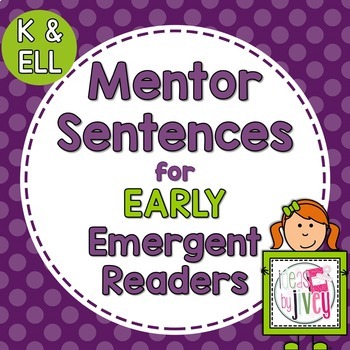Mentor Sentences Unit: Ten Weeks of Lessons for Early Emergent Readers
- PDF
What educators are saying
Description
Mentor sentences model writing through excellent sentences from your favorite read-aloud books! This set is just what you need to implement mentor sentences in your Kindergarten classroom. I created these with kindergartners in mind, but they would also be appropriate for early emergent readers in first grade, or even ELL students!
These mentor sentences are perfect for integrating reading and writing. Students will listen to you read the mentor text, identify/notice letters, words, and parts of a sentence, read the words of the mentor sentence, arrange the words to re-form the sentence, learn other words that could fit into the sentence, imitate the sentence by writing in their own words, read their sentence, illustrate their sentence, and even create a class book that can be read over and over again. Your emergent readers WILL BE reading AND writing every week!
Not familiar with mentor sentences? Read all about them here!
**Watch a video of Mentor Sentences in ACTION with ELL students in Kindergarten!**
TRY ONE WEEK FOR FREE with The Pigeon Finds a Hot Dog.
Are your readers past the EARLY emergent stage? Check out these units!
Ten Weeks of Lessons for Emergent Readers
Unit 2: Ten Weeks of Lessons for Emergent Readers
Unit 3- Ten Weeks of Lessons for Emergent Readers
Ten Weeks of SEASONAL Lessons for Emergent Readers
Not sure if you should get the Early Emergent or Emergent Mentor Sentences? Read this post to see which set you should get!
*****************************************************************************
WHAT’S INCLUDED?
I walk you through each day's lesson for 10 weeks- all the work is done! Each lesson includes the teacher sentence page, directions/guidance for each day for the teacher, the student sentence page with words out of order (students cut and glue them back in order), vocabulary picture clue word cards (when applicable) in color and black and white, the student imitation page, and a class book cover in color and black and white.
Please download the preview to see the layout!
There is a 5-page introduction in this unit with pictures included of how to use mentor sentences (VERY detailed, day-by-day), followed by 10 lessons for the following books:
Chrysanthemum by Kevin Henkes
-name
Today I Feel Silly by Jamie Lee Curtis
-emotions/feelings
The Pigeon Finds a Hot Dog! by Mo Willems
-food
The Napping House by Audrey Wood
-places
Don’t Let the Pigeon Drive the Bus! by Mo Willems
-vehicles
Diary of a Worm by Doreen Cronin
-school supplies
A House is a House for Me by Mary Ann Hoberman
-animal homes
Brown Bear, Brown Bear, What Do You See? by Bill Martin, Jr.
-colors
Mary Wore Her Red Dress by Merle Peek
-clothes
The Very Hungry Caterpillar by Eric Carle
-fruit
As a former first grade teacher, I used to LOVE reading these books, so I know many of you do, too! They are definitely some of my favorites. I chose books that would be in most personal libraries or school media centers. Ideally, this unit would work best at the beginning of the school year (based on the skills especially), but it could really be started at any point.
*****************************************************************************
WHAT ELSE DO I NEED?
Don't forget to get the fall/winter holiday seasonal mini-unit, the mini-unit with snowy winter themed lessons, and a set of Spring themed lessons!
*****************************************************************************
HELP ME PLAN!
You don’t need to do all of the mentor sentence lessons in the order they come in the units. When I created the units, I put them in an order that progressed in difficulty, so these lessons spiral, but it is not necessary to stay in that order.
*****************************************************************************
WHAT ABOUT OTHER GRADE LEVELS?
Mentor Sentences can be done in ALL grades! Please tell your teacher friends about mentor sentences for their grade:
Kindergarten & ELL (Early Emergent Readers)
There are three volumes for grades 3-5 to help prevent repetition of mentor sentence lessons among grades in the same school.
*****************************************************************************
Please remember, this purchase is for the use of one teacher. It is not intended to be shared. Please use the 'additional license' purchase if more than one teacher will be using it. Thank you!
*The mentor sentence lessons I have created are adapted from the ideas of Jeff Anderson. These lessons were born from the routine that worked well in my classroom, and the demos and examples I present are variations of Jeff Anderson's methods. This is not the only way to "do" mentor sentences in your classroom.*
Copyright © 2015 Ideas By Jivey, LLC
All rights reserved by author, Jessica Ivey.
Permission to copy for single classroom use only.
Electronic distribution limited to single classroom use only.
Not for public display.
Leave feedback to earn credits for future purchases! Become a follower to receive updates about future mentor sentence units as well!





